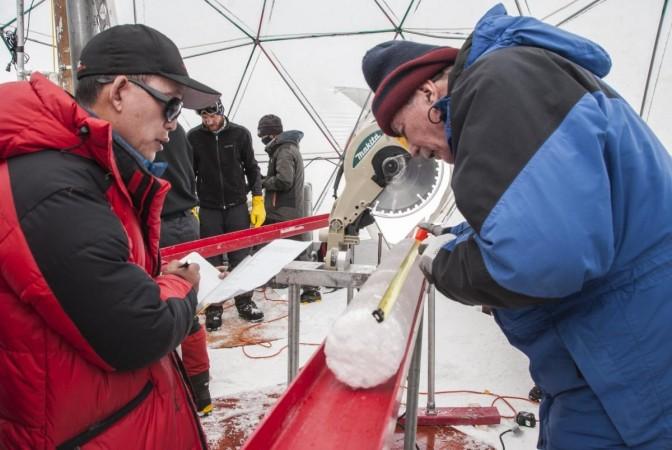With the COVID-19 pandemic continuing to devastate several parts of the world, the mention of viruses can do nothing other than cause worry. And the idea of finding viruses that are millennia old is sufficient to arouse more fear. However, not all viruses are harmful to human beings or animals. Now, scientists have reported the discovery of multiple viruses, that are nearly 15,000 years old, in ice samples from China.
The multi-institutional study announced the discovery of over 30 viruses— including 28 novel ones—from two ice cores collected from the Guliya ice cap in China's Tibetan Plateau. According to the researchers, the bacteria-killing viruses, or phages, survived on account of being frozen for thousands of years. The study was published in the journal Microbiome
"These glaciers were formed gradually, and along with dust and gases, many, many viruses were also deposited in that ice. The glaciers in western China are not well-studied, and our goal is to use this information to reflect past environments. And viruses are a part of those environments," said Dr. Zhi-Ping Zhong, lead author of the study, in a statement.
Dozens of Novel Viruses

Ice cores that were obtained in 2015 from the Guliya ice cap in the section of the Tibetan Plateau located in Western China were examined by the team. The cores were collected at the summit of Guliya—the origin of the ice—which is 22,000 feet above sea level. Consisting of multiple layers of ice that were deposited over the course of time, constituents of the atmosphere were trapped within the cores.
Serving as a form of a timeline, these multiple layers provide researchers with insights about microorganisms and gases across time, and most importantly, climate change. Through their attempts to date the ice cores, the authors ascertained that the ice was around 15,000 years old.
When the ice was examined further, genetic codes for 33 viruses were discovered. While four of them have been identified in the past, at least 28 of these viruses were found to be novel. Around half of these appear to have survived when they were frozen due to the ice.

Dr. Matthew Sullivan, co-author of the study, explained: "These viruses have signatures of genes that help them infect cells in cold environments - just surreal genetic signatures for how a virus is able to survive in extreme conditions. These are not easy signatures to pull out, and the method that Zhi-Ping developed to decontaminate the cores and to study microbes and viruses in ice could help us search for these genetic sequences in other extreme icy environments - Mars, for example, the moon, or closer to home in Earth's Atacama Desert."
Finding their Place amongst Other Viruses
In the case of viruses, a common and universal gene does not exist. Therefore, multiple steps are involved in the naming of a new virus and establishing its place amongst other known viruses. For this, the gene sets of unidentified viruses are compared with that of known ones. Gene sets are collections of genes with which particular biological processes are associated. Scientific databases act as catalogues for gene sets of classified viruses.

Through their comparisons with databases, the team learnt that four of the viruses in the cores from the Guliya ice cap had already been discovered and classified earlier. They fell within the three genera of the family Siphoviridae and Myoviridae (one genus). Both families are phages (i.e) they infect bacteria. It has been gleaned that viral pathogens in much lower concentrations exist in soil or oceans.
Based on the databases of known viruses and the environment in which the ancient viruses were found, the analysis revealed that it is likely that the viruses arose in plants or soil and not in humans or animals. The research is of great significance as the study of viruses in glaciers is a comparatively new field.
"Just two previous studies have identified viruses in ancient glacier ice. But it is an area of science that is becoming more important as the climate changes," pointed out Dr. Lonnie Thompson, senior author of the study.
Known Bacteria Trapped In Ice for Millenia

While nearly 35 viruses were found in the two ice cores, they were not the only microorganisms preserved in ice for centuries. Several common glacier-ice lineages of bacteria were also found in the cores samples. They mostly belonged to the genera Flavobacterium, Herminiimonas, Janthinobacterium, Methylobacterium, Polaromonas, and Sphingomona.
Interestingly, the microbial constituents were considerably different between the two cores owing to different climatic conditions at the time of their deposition. According to the authors, the findings of the study can help provide other researchers insights into the evolution of viruses over centuries. Importantly, the ultra-clean method of analyzing microorganisms in ice created for the study can benefit future studies in the area.
"We know very little about viruses and microbes in these extreme environments, and what is actually there. The documentation and understanding of that is extremely important: How do bacteria and viruses respond to climate change? What happens when we go from an ice age to a warm period like we're in now?" concluded Dr. Thompson.

















